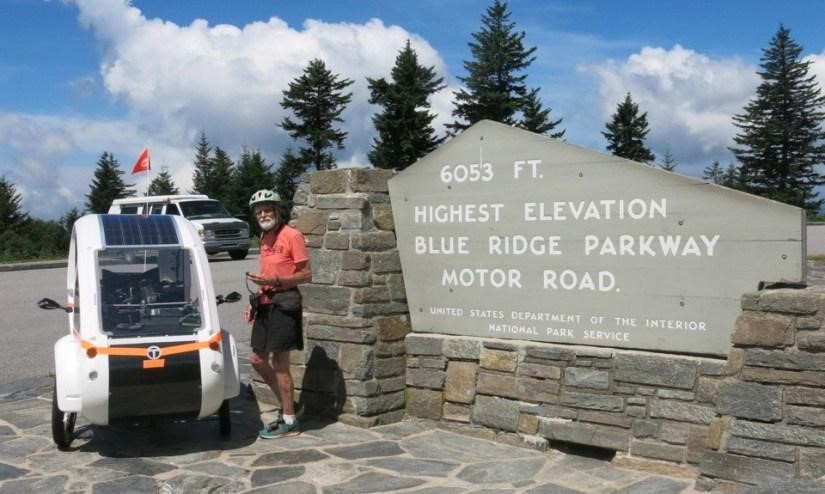
28 Apr Eighty-Year-Old Pedals His ELF from Virginia to Arkansas
We’re delighted to feature a condensed ELF Testimonial by Marvin Glenn.
I’m very pleased with my ELF, which has now logged over 2,000 miles in a variety of conditions. My primary purpose for buying it was to help me stay physically fit during my sunset years. I’m 80 years old, with slowly dimming eyesight, stiffening joints, weakening muscles, and slowing reaction times. After suffering some hard falls with my 2- wheeled bike I decided a trike would be safer for me, and the electric assist is a bonus.
My new ELF Solo and I had no serious problems during our 1600 mile delivery ride from Claremont VA (near Jamestown) to our home near Mena, AR. The front tires wore out in less than 1,000 miles, probably due to the extreme camber, but I suppose the camber is needed for best steering and cornering.
Of course the ELF attracted attention everywhere we stopped, and I was sometimes interviewed for local papers. The unconventional design may have helped reduce annoyance among drivers, who usually didn’t mind slowing down and staring at a us until they could safely pass. On very busy roads (which we avoided when possible) my wife Ann followed in our van with hazard lights flashing. I pedaled constantly, but used the motor to maintain a higher speed (especially when in traffic) than I could under pedal power alone. Otherwise she just rendezvoused with me for lunch, and at campgrounds or motels each evening. We often took several hours for lunch, with the ELF charging in the sun.
It’s hard to estimate my speed under pedal power alone. Roads seem to always go uphill (requiring solar power assist), or downhill (fast coasting or easy pedaling). I believe I can pedal 10-12 mph on level paved roads without power assist. Our daily runs were usually only 40-60 miles, and our longest was 82 miles.
Our camper van has an inverter capable of charging the ELF’s spare battery, which was useful on longer runs and when overnight stops didn’t include electricity. I liked to start each morning with 2 fully charged batteries. After 15-20 miles I’d switch batteries and Ann would start charging the partly depleted battery as she drove to the next rendezvous. A third battery would have been useful for longer runs.
I try to keep battery output below 750 watts by gearing down and pedaling harder on hills and when starting. The motor can use 1800-2000 watts for a few moments when straining, which would drain the battery in a hurry.
We stayed on byways as much as possible, to avoid heavy traffic. Our favorite stretches were along the Blue Ridge Parkway, the Cherahala Skyway, and the Natchez Trace, where commercial trucks are prohibited, the speed limit is 45-50, and motorists are warned to look out for cyclists.
Sometimes our efforts to avoid well traveled routes led us into unexpected situations. In small towns with no motels or campgrounds, strangers sometimes invited us to park in their backyard or driveway. We made friends in unexpected places.
Ann and I live in the Ouachita National Forest in western Arkansas, a mile from the nearest paved road. The rough, rocky, hilly lane connecting our house with the pavement fords a creek (normally only ankle deep) several times, and is plagued with loose rocks and exposed roots. Our Subaru Forester has no trouble with the lane, but low slung vehicles (and UPS trucks) shy away from it. My ELF and I traverse this lane most days to check our mailbox at the highway. Three wheels and power assist allow me to ease across the creek, and over large bumps and roots slower than a bike, with good control. I doubt that Rob Cotter designed the ELF to be used in such rough conditions. However, it has held up surprisingly well so far.
The ELF is a novelty in our area.I was invited to display it last spring in the Mena Earth Day Exposition, alongside a Tesla. Talk about extremes!
My ELF certainly keeps our life interesting.


